The Clarkdale Review: Intel's Core i5 661, i3 540 & i3 530
by Anand Lal Shimpi on January 4, 2010 12:00 AM EST- Posted in
- CPUs
Ridiculously Fun to Overclock
We’ll start off with the obligatory maximum stock VID overclock of a 661 ES Clarkdale using Intel’s retail cooler:
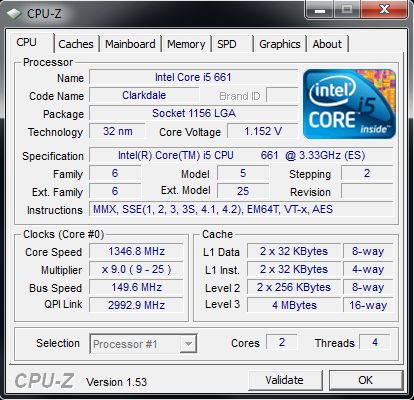
Maximum overclock @ stock voltages (3874MHz)
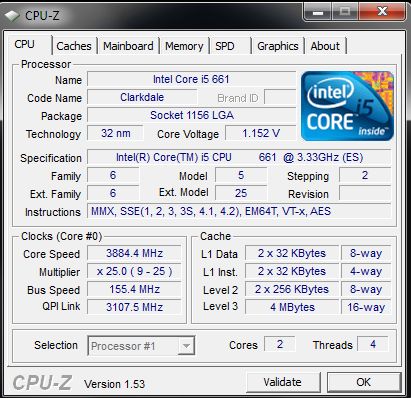
Maximum overclock @ stock voltages without Turbo
With increased core VID, speeds up to 4.3GHz are possible on the stock cooler:
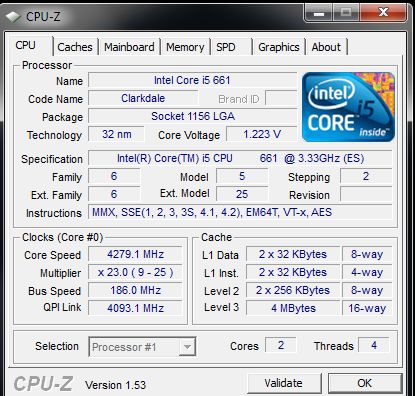
A 0.1V boost puts you in the 4.3GHz ballpark.
Watercooling
Clock for clock performance of Clarkdale against other platforms may not be impressive, but frequency scaling with good cooling is:
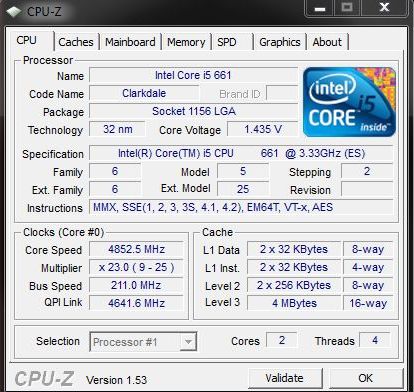
4853 MHz stable comes in with a processor load voltage of around 1.438V. Memory performance is related directly to the QPI link ratio. For best performance, keep the QPI link speed as close as possible to CPU core speed to minimize buffer hold times for lower memory access latency.
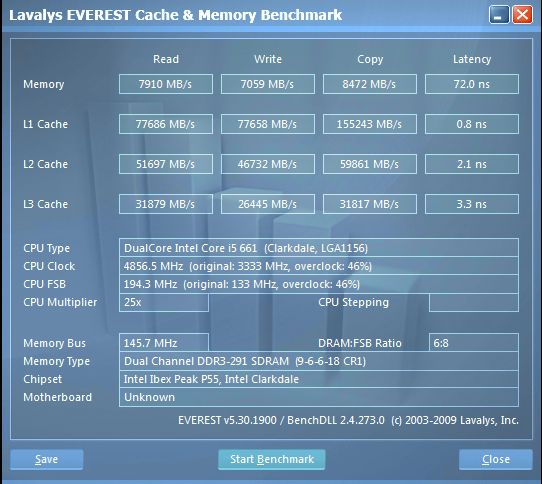
12X QPI Multiplier
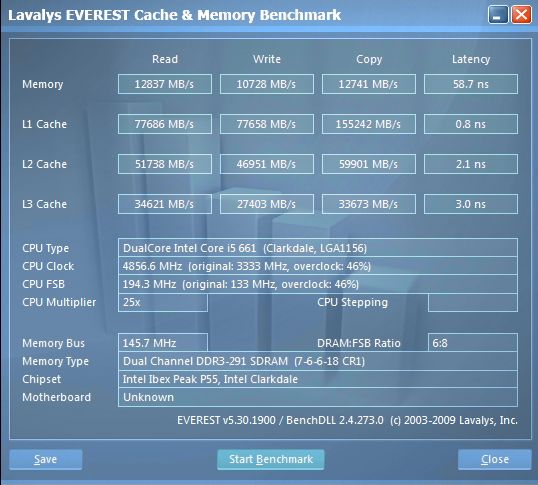
24X QPI Multi
The bandwidth figures are not stellar on either side of the scale (bear in mind the Everest bench DLL needs an update for Clarkdale). However, the higher QPI multiplier ratio is essentially free for the taking; requiring no additional IMC (VTT) voltage increase until BCLK is increased past 210 or so.
Like Lynnfield and Bloomfield, odd CPU multiplier ratios are more stable than even, although the disparity is less pronounced on Clarkdale. We found that even multipliers needed higher VCore at the same overall processor frequency or needed to be run at a lower overall overclock for stability. We’re not sure on the exact cause of this issue but it’s likely to be related to frequency synthesis within the CPU and downstream logic sampling.
Another caveat with Clarkdale overclocking is that the platform seems to be limited to memory speeds below 1600MHz as soon as you increase BCLK significantly (speeds over 1600Mhz are possible at stock BCLK). We’d hedge bets this is due to the memory controller relying on a preset DRAM clock skew table like Intel’s Front Side Bus architectures of old. The current DRAM frequency ceiling means that you’ll be shooting for CAS 5/6 capable memory between 1300-1600MHz for best performance with 4GB of RAM. 8GB configurations require a loose set of sub-timings, and also a 2N Command Rate to achieve 1600 MHz stable on our sample processor.
Sub-Zero
Bloomfield was hit and miss when it came to frequency scaling at low temperatures. Clarkdale seems to be a different animal altogether:

This is what ‘Clarkie’ is good at..
This screenshot was taken with our cascade cooling the CPU. Evaporator head temperatures were in the region of -115 Celsius. Most Lynnfield/Bloomfield CPUs were out of their comfort zone at these temperatures, but Clarkdale seems to be at home. You still get the occasional cold boot bug, but most of the ES CPUs will run benchmarks right down to the boiling point of LN2 (motherboard permitting). We’ve seen screenshots of 3D benchmarking above 6.5GHz and Super Pi runs edging close to 7GHz. Sounds great, but unfortunately, Super Pi 1M is the only benchmark where Clarkdale is really competitive. Once you’re past 230 BCLK, you have to leave QPI frequency on the floor which hurts memory performance in a big way. Couple that with the 1600MHz or so cap on DRAM frequency and you’ll understand why Super Pi 32m doesn’t fare so well on this platform. 3D performance in Futuremark’s 3DMark05 is just about competitive with the current ‘top’ Bloomfield results if you can run Clarkdale at 6.5GHz throughout the bench. The upshot is that we think there will be more good Clarkdale chips capable of 6.5GHz than there are Bloomfield CPUs that can run 3D benchmarks at 5.4GHz. The funny thing is that P55 motherboards using an NF200 to provide triple CrossFire/SLI might actually be the way to go for benchmarks like 3D Mark 05 if you’re into competitive benchmarking!
While Clarkdale may not be the fastest performer from Intel, it’s probably the most fun to overclock.










93 Comments
View All Comments
marc1000 - Monday, January 4, 2010 - link
Indeed, I want an Atom+ION, but it has not yet come to public availability in Brazil. And Intel is killing ION with the new Atoms, so I believe I won't ever see a Atom+ION board here, because the stores will only launch only the "newer" Atom boards (that is, IF they even launch it...)efficientD - Saturday, January 9, 2010 - link
The other problem with and atom setup is the low cost no L3 cache Athalons. With a decent 785G mainboard, you can get much better performance in only a slightly bigger package for about the same HTPC money. That is the direction I would go if I could build an HTPC right now.IntelUser2000 - Monday, January 4, 2010 - link
The reason for high idle and in some way, high load power is due to the Asus board. Not only that, but the H57 chipset.The Intel H55 mobo will lower power consumption enough to get it below the i5 750 and i7 860.
Kaleid - Monday, January 4, 2010 - link
Would these be chips on would dare to overclock considering the foxconn socket problems that has been reported here @ anandtech?Zool - Monday, January 4, 2010 - link
Its quite confusing now, with 9 desktop and 11 mobile i-xxx cores now. Not a single digit shows core numbers or the gpu on the new 32nm cpus.Actualy its a total mess now for a average user.
marc1000 - Monday, January 4, 2010 - link
I second your opinion!!! Perhaps Intel hired some marketing folks from Nvidia!!! =DHarry Lloyd - Monday, January 4, 2010 - link
So which chip is responsible for HDMI Audio - the CPU, or the H5x chipset?Can we get HDMI audio support with a Lynnfield CPU?
And one other thing - I assume we can use HDMI audio without haeving to use the integrated GPU (for display) when we have a PCI-E card?
DigitalFreak - Monday, January 4, 2010 - link
The GPU on the processor.Alberto - Monday, January 4, 2010 - link
The main problem is the Motherboard, likely an early sample not much optimized. Both Xbit Lab and The Tech Report have found a lower idle system power consumption in the new Intel plataform versus the Lynnfield solution. Maybe This article needs of a fast update :-)Alberto - Monday, January 4, 2010 - link
The italian site www.hwupgrade.it have discovered even better results. Over an Intel DH55TC motherboard this new cpu is IMPRESSIVE at idle.Intel seems right again.